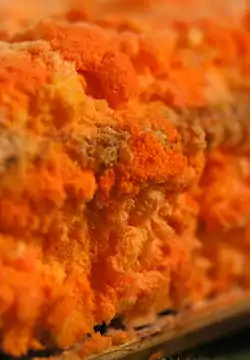Oncom
Oncom (Indonesian pronunciation: [ɔnˈtʃɔm]) is one of the traditional staple foods of West Java (Sundanese) cuisine of Indonesia. There are two kinds of oncom: red oncom and black oncom. Oncom is closely related to tempeh; both are foods fermented using mold.[1]
 Closer view of red oncom mold. | |
| Course | Main course |
|---|---|
| Place of origin | Indonesia |
| Region or state | West Java, Nationwide in Indonesia and Southeast Asia countries |
| Associated national cuisine | Indonesia |
Usually oncom is made from the by-products from the production of other foods: soy pulp left from making tofu, peanut press cake left after the oil has been pressed out, cassava tailings when extracting the starch (pati singkong), coconut press cake remaining after oil has been pressed out or when coconut milk has been produced. Since oncom production uses by-products to make food, it increases the economic efficiency of food production.
Red oncom has been found to reduce the cholesterol levels of rats.[2]
Black oncom is made by using Rhizopus oligosporus while red oncom is made by using Neurospora intermedia var. oncomensis.[3] It is the only human food produced from Neurospora.
Toxicity

In the production of oncom, sanitation and hygiene are important to avoid contaminating the culture with bacteria or other fungi like Aspergillus flavus (which produces aflatoxin). Neurospora intermedia var. oncomensis and Rhizopus oligosporus reduce the aflatoxin produced by Aspergillus flavus.[4] However, aflatoxin-producing molds (Aspergillus spp.) are often naturally present on peanut presscake. Furthermore, coconut presscake can harbor the very dangerous Burkholderia gladioli, which produces two highly toxic compounds – bongkrek acid and toxoflavin. Shurtleff and Aoyagi address toxicity in their book section on oncom.
While it is known that soybeans are the best substrate for growing R. oligosporus to produce tempeh, oncom has not been as thoroughly studied; the best fermentation substrates for producing oncom are not yet known.
Cooking methods

Oncom can be prepared and cooked in various ways. It can be simply deep fried as gorengan fritters, seasoned and cooked in a banana leaf pouch as pepes, or roasted, seasoned and mixed with steamed rice as nasi tutug oncom.[5] Oncom is also a selected fillings for comro, lontong and arem-arem rice dumplings. Comro in particular is a popular Sundanese snack, the name was an abbreviation from oncom di jero which literally means "oncom inside".[6]
See also
References
- Sastraatmadja, D. D.; et al. (2002). "Production of High-Quality Oncom, a Traditional Indonesian Fermented Food, by the Inoculation with Selected Mold Strains in the Form of Pure Culture and Solid Inoculum". Journal of the Graduate School of Agriculture, Hokkaido University. 70: 111–127. CiteSeerX 10.1.1.866.6352. hdl:2115/13163.
- "Plasma cholesterol reduction by defatted soy ontjom (fermented with Neurospora intermedia) in rats fed a cholesterol-free diet". usda.gov. Archived from the original on 19 July 2009. Retrieved 25 March 2019.
- Ho, C.C. (1986). "Identity and characteristics of Neurospora intermedia responsible for oncom fermentation in Indonesia". Food Microbiology. 3 (2): 115–132. doi:10.1016/S0740-0020(86)80035-1.
- Nout, M.J.R. (December 1989). "Effect of Rhizopus and Neurospora spp. on growth of Aspergillus flavus and A. parasiticus and accumulation of aflatoxin B1 in groundnut". Mycological Research. 93 (4): 518–523. doi:10.1016/S0953-7562(89)80046-2.
- "Seven traditional Indonesian rice dishes you should try". The Jakarta Post. Retrieved 2020-04-07.
- "Serupa Namun Tak Sama, Ini Perbedaan Combro dan Misro". Kumparan (in Indonesian). Retrieved 2020-04-07.
Also, There is an appendix on oncom in Aoyagi and Shurtleff's _Book of Tempeh; Professional Edition_, online at Google books.

